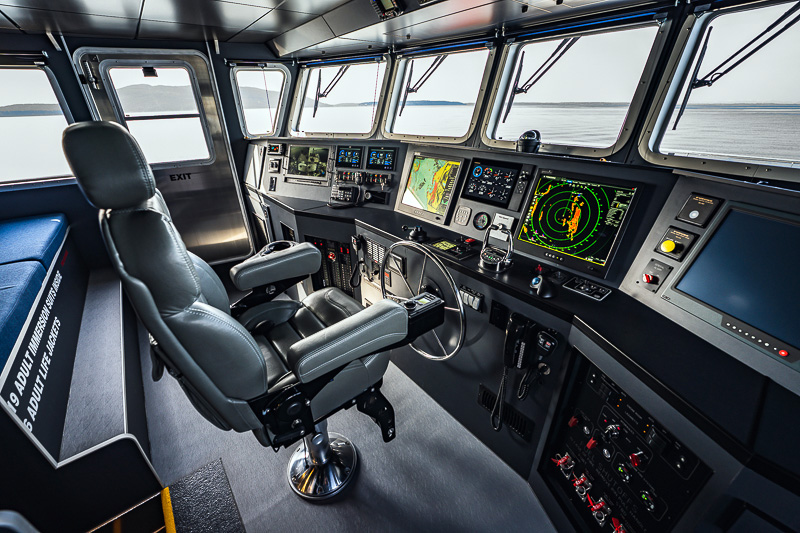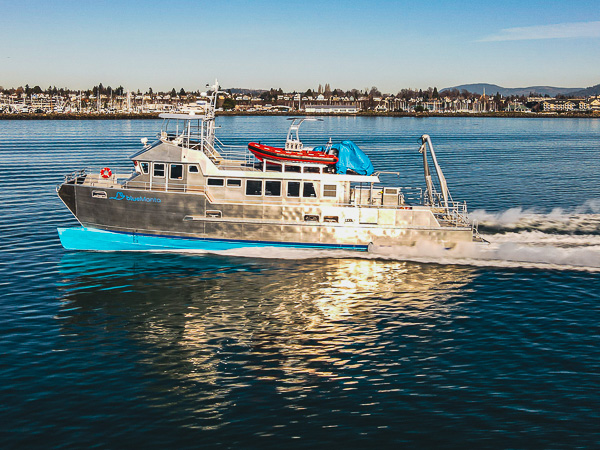
Cascadian commercial vessel designers and boatbuilders are busy serving the needs of the industry.
The Pacific Northwest is a hotbed of maritime talent, both behind the naval design desk and in the boatyard. Herein is a glance at several notable recent and ongoing vessel projects with roots in Cascadian companies. From small but mighty ice-proofed tugboats and cutting-edge research vessels to innovative multi-hulls and hybrid-electric commercial ferries, our region leaves its mark.
All American Marine
All American Marine (AAM), based in Bellingham, Wash., has a specialty—aluminum boat building and multihull designs. The company is the exclusive North American builder with Nic de Wall of Teknicraft Design, Ltd of New Zealand. In the spring of 2021, AAM joined the Bryton Marine Group. The forward-thinking organization has made waves with their new ferry Sea Change, purportedly the world’s first commercial vessel powered entirely with hydrogen fuel cells.
Their recently delivered vessels include a twin engine, 73-foot hydrographic survey vessel r/v Shackleford for NV5-Geodynamics. The Teknicraft Design vessel will service the offshore wind market and complete other scientific survey missions on the U.S. Eastern Seaboard. The vessel was named after Shackleford Banks, a barrier island of the Cape Lookout National Seashore.

“This vessel will enable Geodynamics to take their business to the next level, provide unmatched services and expand their scientific activities on the East Coast significantly,” AAM President & COO Ron Wille said. “The vessel will also help advance the rapidly growing windfarm industry.”
AAM delivered another 73-foot twin engine, aluminum catamaran research vessel from the Teknicraft Design desk, this time for Bluetide Puerto Rico. The vessel, r/v Blue Manta, is Bluetide’s first boat for marine research, education, innovation and conservation in Puerto Rico as part of a blue economy effort in the Caribbean region.
“The acquisition of this vessel will give us another perspective of the sea as an asset and a resource to educate ourselves, explore and innovate in a collaborative way, spearheading a new economy for the region,” Bluetide co-founder Guifre Tort said.
According to AAM business development manager Daniel Zach, the company is launching a research vessel for the University of Hawaii within the next few weeks.
Glosten
Glosten is a marine engineer design firm founded in 1958 by naval architect and marine engineer L.R. Glosten in Seattle. The company has made its mark on history with the iconic R/P FLIP for Scripps Institution of Oceanography in the 1960s and the top-secret Soviet submarine recovery barge for the CIA’s Project Azorian in the 1970s.
Glosten designed and provided construction support for the tugboat Seaway Trident that culminated with successful sea trials this year. Seaway Trident is an ice-strengthened tugboat based upon Glosten’s HT-60 concept. The tugboat is highly customized to serve the Great Lakes St. Lawrence Seaway Development Corporation where an agile tug that can weather icy conditions while performing construction work, maintenance to navigation and ice management in and around lock chambers is needed.
The 60-foot tug has a 28-foot beam. Schottel Z-drive units are powered by a pair of Caterpillar C18 diesel engines for a combined 1,300 bhp at 1,800 RPM. The deck is outfitted with a Markey Machinery headline winch and fully foldable Heila Marine deck crane.
Glosten is also providing on-site construction and support at the Freire Shipyard for the new r/v David Packard that should be completed this year. The David Packard began in 2010 as a concept study for the Monterey Bay Aquarium Research Institute in which Glosten was tasked with developing a new research vessel for dedicated remotely operated vehicles and scientific ocean-going operations.
The institute re-engaged with Glosten in 2018 and now the David Packard is reaching completion. The 164-foot vessel will be able to accommodate 12 crew members and 18 scientists. The monohull design with twin L-drive stern thrusters and a retractable tunnel bow thruster should be capable of 12 knots cruising speed with a range of 4,300 nautical miles.
Key features include ROV-tailored operations, 360-degree pilothouse visibility, and the ability to manage maneuvering and on-station operations with minimal crewing. The David Packard, which is named after the institute’s founder, will enable continued exploration of the deep sea.
Glosten is also working with Oregon State University to lead the design and acquisition of three Regional Class Research Vessels for multidisciplinary research and environmental education.
The company developed the contract design for the research vessels and is providing support throughout construction. The vessels will supply researchers with real-time data from a wide array of scientific missions and are being equipped with advanced sensors and ocean instrumentation, sample collection systems, integrated mid- and shallow-water acoustic multibeam bottom mapping and a large aft deck for multidisciplinary operations. By using advanced communications technologies, the vessels will bring science at sea to classrooms, the public and researchers ashore.
Elliott Bay Design Group
Elliott Bay Design Group is an employee-owned, full-service, Seattle-based naval architecture firm established in 1988. The company is involved in multiple projects, notably several commercial ferries in which they specialize.
In March, Fire Island Ferries welcomed their new commercial ferry, the Elliott Bay-designed Fire Island Maid, after construction was completed by Metal Shark at its Bayou La Batre, Ala. shipyard. Since 1948, Fire Island Ferries provides passenger and freight shipping services from Bay Shore, N.Y. to other communities along the Great South Bay of Fire Island.
The 70-foot-long, 23-foot beam steel hull ferry has an aluminum superstructure with a hydraulic ramp for heavy equipment loading and unloading. The deck is built to support fully loaded concrete trucks and cargo up to 100,000 pounds. Fire Island Maid is powered by twin Cummins QSL9 Tier 3 marine engines with a ZF Marine CruiseCommand control system and Twin Disc transmissions.
The ferry’s hybrid propulsion system will be able to operate on either zero-emission battery-only power or on a battery-assisted hybrid with diesel backup.
According to Elliott Bay, the low-emission vessel will have a cruising speed of 10 knots and is projected to reduce carbon emissions by 600 tons annually.
“We are excited to add Fire Island Maid to our fleet of vessels,” Fire Island Ferries General Manager Dave Anderson said. “EBDG listened and provided a more efficient structure and arrangement. I know this new ferry will make a difference for our passengers and shipping customers.”
In other Elliott Bay ferry news, New York City announced it will build its first hybrid-electric ferry with plans for a new Governors Island ferry to start operations in the summer of 2024. The currently unnamed 1,200-passenger hybrid, Elliott Bay-designed ferry will provide technical and support services during the ferry’s construction.
The group also announced its design of a hybrid-electric passenger vehicle ferry for Casco Bay Lines of Portland, Maine. The 164-foot Machigonne II will enter the construction phase at Senesco Marine of North Kingstown, R.I. It is estimated by the design group that the ferry will reduce 800 tons of carbon dioxide annually while also improving air quality in the area.
The ferry is expected to enter service in 2024.
Beyond commercial ferry projects, Elliott Bay has partnered with Maritime Partners, e1 Marine, and ABB to design and build the industry’s first IMO 2030 compliant long-range towboat.
e1 Marine’s reformer technology converts methanol to hydrogen directly onboard the vessel to eliminate the fuel transfer and storage complications associated with other low carbon emission alternatives.
The methanol reformer hydrogen tugboat should have a 550-mile or four-day range between refueling and be scalable from 1,700 to 3,500 horsepower. The world’s first methanol-fueled towboat, m/v Hydrogen One, will soon join the Maritime Partners LLC fleet.
Elliott Bay also made a splash at the International Workboat Show in New Orleans with the company’s announced harbor power and charging barge. The barge is designed to deliver seven megawatts of continuous power generated by methanol as a mobile platform at the service of ports and harbors.
The charging platform is less than 225 feet in length and meant to support operations of vessels using more sustainable propulsion technologies.
Norris Comer is a Seattle-based writer and author. His debut memoir, Salmon in the Seine: Alaskan Memories of Life, Death, & Everything In-Between is now available wherever books are sold. You can find him on Substack, Instagram and at norriscomer.com. He can be reached via email at norriscomer@substack.com.
